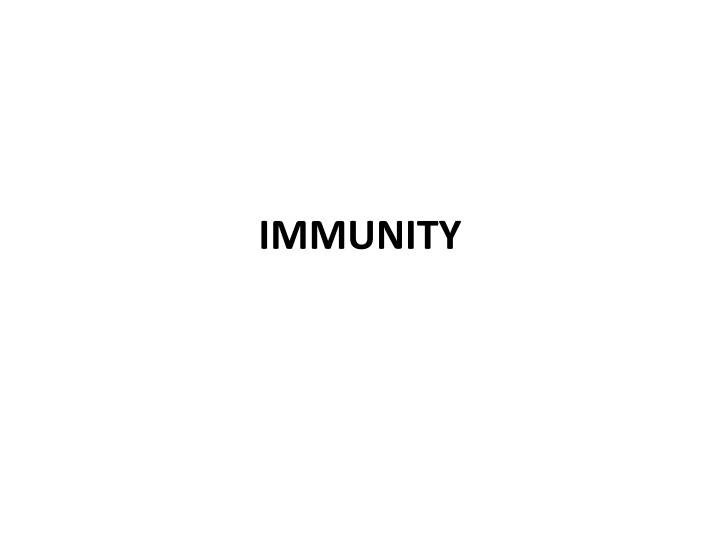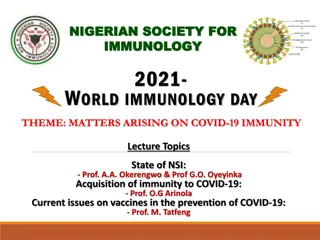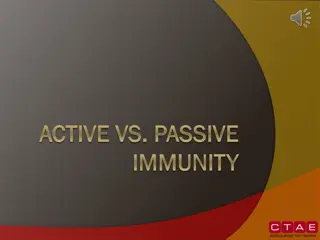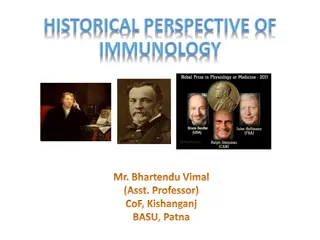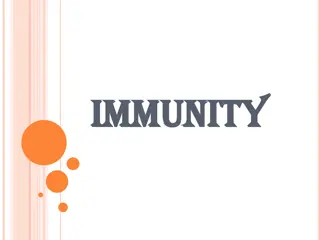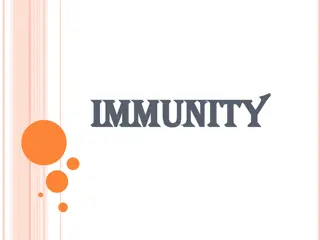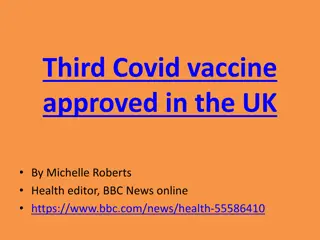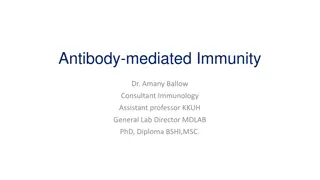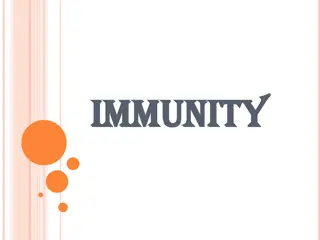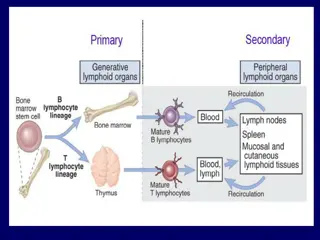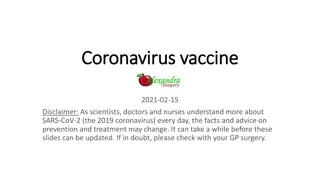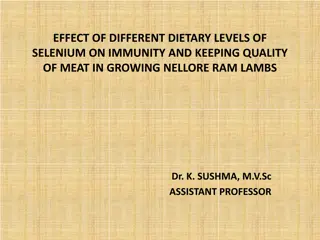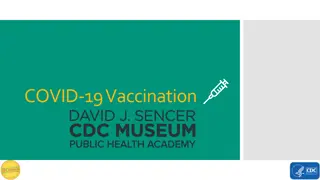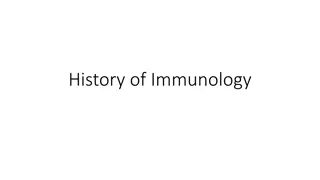IMMUNITY
Immunity is the body's ability to resist pathogens, with two main types: innate and acquired immunity. Innate immunity acts as the first line of defense, while acquired immunity is specific and powerful. Lymphocytes play a crucial role in acquired immunity, developing from bone marrow and differentiating into T and B lymphocytes. T lymphocytes are processed in the thymus, giving rise to different types with distinct functions. Learn more about the fascinating world of immunity and how the body defends itself against foreign invaders.
Download Presentation

Please find below an Image/Link to download the presentation.
The content on the website is provided AS IS for your information and personal use only. It may not be sold, licensed, or shared on other websites without obtaining consent from the author.If you encounter any issues during the download, it is possible that the publisher has removed the file from their server.
You are allowed to download the files provided on this website for personal or commercial use, subject to the condition that they are used lawfully. All files are the property of their respective owners.
The content on the website is provided AS IS for your information and personal use only. It may not be sold, licensed, or shared on other websites without obtaining consent from the author.
E N D
Presentation Transcript
DEFINITION AND TYPES OF IMMUNITY Immunity is defined as the capacity of the body to resist the pathogenic agents. It is the ability of the body to resist the entry of different types of foreign bodies like bacteria, virus, toxic substances, etc. Immunity is of two types: I. Innate immunity II. Acquired immunity.
INNATE IMMUNITY OR NONSPECIFIC IMMUNITY Innate immunity is the inborn capacity of the body to resists the pathogens. By chance, if the organisms enter the body, innate immunity eliminates them before the development of any disease. This type of immunity represents the first line of defense against any Therefore, it is also called nonspecific immunity. type of pathogens.
Examples of innate immunity are: 1. Destruction of toxic substances or organisms entering digestive tract through food by enzymes in digestive juices. 2. Destruction of bacteria by salivary lysozyme 3. Destruction of bacteria by acidity in urine and vaginal fluid.
ACQUIRED IMMUNITY OR SPECIFIC IMMUNITY Acquired immunity is the resistance developed in the body against any specific foreign body like bacteria, viruses, toxins, vaccines or transplanted tissues. So, this type of immunity is also known as specific immunity. It is the most powerful immune mechanism that protects the body from invading organisms or toxic substances. Lymphocytes are responsible for acquired immunity (Fig. 2) Types of Acquired Immunity Two types of acquired immunity develop in the body: 1. Cell mediated immunity or cellular immunity. 2. Humoral immunity.
DEVELOPMENT AND PROCESSING OF LYMPHOCYTES In fetus, lymphocytes develop from bone marrow. All the lymphocytes are released in the circulation and are differentiated into two categories: 1. T lymphocytes 2. B lymphocytes.
T. LYMPHOCYTES T lymphocytes are processed in thymus. The processing occurs mostly during the period between just before birth and few months after birth. Thymus secretes thymosin which accelerates the proliferation and activation of lymphocytes in thymus. It also increases the activity of lymphocytes in lymphoid tissues. Types of T Lymphocytes During the processing, T lymphocytes are transformed into four types: 1. Helper T cells or inducer T cells 2. Cytotoxic T cells or killer T cells 3. Suppressor T cells 4. Memory T cells.
Storage of T Lymphocytes After the transformation, all the types of T. lymphocytes leave the thymus and are stored in lymphoid tissues of lymph nodes, spleen, bone marrow and the GI tract.
B LYMPHOCYTES B lymphocytes were first discovered in the bursa of Fabricius in birds hence the name B lymphocytes. The bursa of Fabricius is a lymphoid organ situated near the cloaca of birds. The bursa is absent in mammals, and the processing of B lymphocytes takes place in bone marrow and liver.
Types of B Lymphocytes After processing, the B lymphocytes are transformed into two types: 1. Plasma cells 2. Memory cells. Storage of B Lymphocytes After the transformation, B lymphocytes are stored in the lymphoid tissues of lymph nodes, spleen, bone marrow and the GI tract.
ANTIGENS DEFINITION AND TYPES Antigens are the substances, which induce specific immune reactions in the body. The antigens are mostly the conjugated proteins like lipoproteins, glycoproteins and nucleoproteins. Antigens are of two types: 1. Autoantigens or self antigens which are present on the body's own cells like 'A' antigen and 'B' antigen on the RBCs. 2. Foreign antigens or nonself antigens which enter the body from outside.
DEVELOPMENT OF CELL MEDIATED IMMUNITY The cell mediated immunity is offered by T lymphocytes. It involves several types of cells such as macrophages, T lymphocytes and natural killer cells and hence the name cell mediated immunity. It is also called cellular immunity or T cell immunity. It does not involve antibodies. Cellular immunity is the major defense mechanism against infections by viruses, fungi and few bacteria. It is also responsible for delayed allergic reactions and rejection of transplanted tissues.
Cell mediated immunity starts developing when T cells come in contact with the antigens. Usually, the invading microbial or nonmicrobial organisms carry the antigenic materials. These antigenic materials are released from invading organisms and are presented to the helper T cells by antigen presenting cells.
ANTIGEN PRESENTING CELLS Antigen presenting cells are the special type of cells in the body which induce the release of antigenic materials from invading organisms and later present these materials to the helper T cells. Major antigen presenting cells are macrophages. Dendritic cells in spleen, lymph nodes and skin also function like antigen presenting cells.
Role of Antigen Presenting Cells Invading foreign organisms are either engulfed by macrophages through phagocytosis or trapped by dendritic cells. Later, the antigen from these organisms is digested into small peptides. The antigenic peptide products are moved towards the surface of the antigen presenting cells and on loaded
genetic matter of the antigen presenting cells called human leukocyte antigen (HLA). HLA is present in the molecule of class II major histocompatiblility complex (MHC) which is situated on the surface of the antigen presenting cells.
Presentation of Antigen The antigen presenting cells present their class II MHC molecules together with antigen bound HLA to the helper T cells. This activates the helper T cells series of through events Sequence of Events during Activation of Helper T Cells 1. Helper T cell recognizes the antigen bound to class II MHC molecule which is displayed on the surface of the antigen presenting cell. It recognizes the antigen with the help of its own surface receptor protein called T cell receptor.
2. The recognition of the antigen by the helper T cell initiates a complex interaction between the helper T cell receptor and the antigen. This reaction activates helper T cells. 3. At the same time macrophages (the antigen presenting cells) release interleukin-1 which facilitates the activation and proliferation of helper T cells. 4. The activated helper T cells proliferate and the proliferated helper T cells enter the circulation for further actions. 5. Simultaneously, the antigen bound to class II MHC molecules activates the B cells also resulting in development of humoral immunity.
ROLE OF HELPER T CELLS The helper T cells which enter the circulation activate all the other T cells and B cells. The helper T cells are of two types: 1. Helper-1 (TH1) cells 2. Helper-2 (TH2) cells. Role of TH1 Cells TH1 cells are concerned with cellular immunity and secrete two substances: i. Interleukin-2 which activates the other T cells ii. Gamma interferon which stimulates the phagocytic activity of cytotoxic cells, macrophages and natural killer (NK) cells.
Role of TH2 Cells TH2 cells are concerned with humoral immunity and secrete interleukin-4 and interleukin-5 which are concerned with: i. Activation of B cells ii. Proliferation of plasma cells iii. Production of antibodies by plasma cell HLA = Human leukocyte antigen.
ROLE OF CYTOTOXIC T CELLS The cytotoxic T cells that are activated by helper T cells circulate through blood, lymph and lymphatic tissues and destroy the invading organisms by attacking them directly. Mechanism of Action of Cytotoxic T Cells 1. The receptors situated on the outer membrane of cytotoxic T cells bind the antigens or organisms tightly with cytotoxic T cells. 2-Then, the cytotoxic T cells enlarge and release cytotoxic substances like the lysosomal enzymes which destroy the invading organisms. 3. Like this, each cytotoxic T cell can destroy a large number of microorganisms one after another.
Other Actions of Cytotoxic T Cells. 1. The cytotoxic T cells also destroy cancer cells, transplanted cells such as those of transplanted heart or kidney or any other cells, which are foreign bodies. 2. Cytotoxic T cells destroy even body's own tissues which are affected by the foreign bodies, particularly the viruses. Many viruses are entrapped in the membrane of affected cells. The antigen of the viruses attracts the T. cells. And the cytotoxic T cells kill the affected cells also along with viruses. Because of this cytotoxic T cell is called killer cell.
ROLE OF SUPPRESSOR T CELLS The suppressor T cells are also called regulatory T cells. These T cells suppress the activities of the killer T cells. Thus, the suppressor T cells play an important role in preventing the killer T cells from destroying the body's own tissues along with invaded organisms. The the activities of helper T suppressor cells suppress cells also.
ROLE OF MEMORY T CELLS Some of the T cells activated by an antigen do not enter the circulation but remain in lymphoid tissue. These T cells are called memory T cells. In later periods, the memory cells migrate to various lymphoid tissues throughout the body. When the body is exposed to the same organism for the second time, the memory cells identify the organism and immediately activate the other T cells. So, the invading organism is destroyed very quickly. The response of the T cells is also more powerful this time.
SPECIFICITY OF T CELLS Each T cell is designed to be activated only by one type of antigen. It is capable of developing immunity against that antigen only. This property is called the specificity of T cells.
DEVELOPMENT OF HUMORAL IMMUNITY Humoral immunity is the immunity mediated by antibodies. Antibodies are secreted by B-lymphocytes and released into the blood and lymph. The blood and lymph are the body fluids (humours or humors in Latin). Since the B-lymphocytes provide immunity through humors, this type of immunity is called humoral immunity or B cell immunity. The antibodies are the gamma globulins produced by B lymphocytes. These antibodies fight against the invading organisms. The humoral immunity is the major defense mechanism against the bacterial infection. As in the case of cell mediated immunity, the macrophages and other antigen presenting cells play an important role in the development of humoral immunity also.
ROLE OF ANTIGEN PRESENTING CELLS The ingestion of foreign organisms and digestion of their antigen by the antigen presenting cells are already explained. Presentation of Antigen The antigen presenting cells present their class II MHC molecules together with antigen bound HLA to B cells. This activates the B cells through series of events.
Sequence of Events during Activation of B Cells 1. The B cell recognizes the antigen bound to class II MHC molecule which is displayed of the antigen presenting cell. It recognizes the antigen with the help of its own surface receptor protein called B cell receptor. on the surface 2. The recognition of the antigen by the B cell initiates a complex interaction between the B cell receptor and the antigen. This reaction activates B cells. 3. At the same time macrophages (the antigen presenting cells) release interleukin-1 which facilitates the activation and proliferation of B cells. 4. The activated B cells proliferate and the proliferated B cells carry out the further actions. 5. Simultaneously the antigen bound to class II. MHC molecules activates the helper T cells also resulting in development of cell mediated immunity (already explained). Transformation of B Cells the proliferated B cells are transformed into two types of cells: 1. Plasma cells 2. Memory cells.
ROLE OF PLASMA CELLS The plasma cells destroy the foreign organisms by producing the antibodies. Antibodies are globulin in nature. The rate of the antibody production is very high, i.e. each plasma cell produces about 2000 molecules of antibodies per second. The antibodies are also called immunoglobulins. The antibodies are released into lymph and then transported into the circulation. The antibodies are produced until the end of lifespan of each plasma cell which may be from several days to several weeks.
ROLE OF MEMORY B CELLS Memory B cells occupy the lymphoid tissues throughout the body. The memory cells are in inactive condition until the body is exposed to the same organism for the second time. During the second exposure, the memory cells are stimulated by the antigen and produce more quantity of antibodies at a faster rate, than in the first exposure. The antibodies produced during the second exposure to the foreign antigen are also more potent than those produced during first exposure. This phenomenon forms the basic principle of vaccination against the infections.
ROLE OF HELPER T CELLS Helper T cells are simultaneously activated by antigen. The activated helper T cells secrete two substances called interleukin 2 and B cell growth factor, which promote: 1. Activation of more number of B lymphocytes 2. Proliferation of plasma cells 3. Production of antibodies.
ANTIBODIES An antibody is defined as a protein that is produced by B lymphocytes in response to the presence of an antigen. Antibody is globulin in nature and it is also called immunoglobulin (Ig). The immunoglobulins form 20 percent of the total plasma proteins. The antibodies enter almost all the tissues of the body. Types of Antibodies Five types of antibodies are identified: 1. IgA (Ig alpha) 2. IgD (Ig delta) 3. IgE (Ig epsilon) 4. IgG (Ig gamma) 5. IgM (Ig mu).
Among these antibodies, IgG forms 75 percent of the antibodies in the body. Structure of Antibodies Antibodies are gamma globulins and are formed by two pairs of chains namely, one pair of heavy or long chains and one pair of light or short chains Mechanism of Actions of Antibodies The antibodies protect the body from the invading organisms in two ways: 1. By direct actions 2. Through complement system.
1. Direct Actions of Antibodies Antibodies directly inactivate the invading organism by any one of the following methods: i. Agglutination: In this, the foreign bodies like RBCs or bacteria with antigens on their surfaces are held together in a clump by the antibodies. ii. Precipitation: In this, the soluble antigens toxin are converted into insoluble forms and then precipitated. iii. Neutralization: During this, the antibodies cover the toxic sites of antigenic products. iv. Lysis: In this, the antibodies rupture the cell membrane of organisms and then destroy them.
2. Actions of Antibodies through Complement System The complement system is the one that enhances or accelerates various activities during the fight against the invading organisms. It contains plasma enzymes, which are identified by numbers from C1 to C9.. Functions of Different Antibodies 1. IgA plays a role in localized defense mechanism in external secretions like tear. 2. IgD is involved in recognition of the antigen by B lymphocytes. 3. IgE is involved in allergic reactions. 4. IgG is responsible for complement fixation. 5. IgM is also responsible for complement Fixation.
Specificity of B Lymphocytes Each B lymphocyte is designed to be activated only by one type of antigen. It is also capable of producing antibodies against that antigen only. This property of lymphocyte is called B specificity. NATURAL KILLER CELL Natural killer (NK) cell is a large granular cell with indented nucleus. It is considered as the third type of lymphocyte. It is not a phagocytic cell but its granules contain hydrolytic enzymes which causes lysis of cells of invading organisms.
Functions of NK Cell The NK cell: 1. Destroys the viruses 2. Destroys the viral infected or damaged cells, which might form tumors 3. Destroys the malignant cells and prevents development of cancerous tumors. 4. Secretes cytokines such as interleukin-2, interferons, colony stimulating factor (GM-CSF) and tumor necrosis factor-
CYTOKINES Cytokines are the hormone like small proteins acting as intercellular messengers (cell signaling molecules) by binding to specific receptors of target cells. These non antibody proteins are secreted by WBCs and some other types of cells. Their major function is the activation and regulation of general immune system of the body. Cytokines are distinct from the other cell signaling molecules such as growth factors and hormones. Cytokines are classified into several types: 1. Interleukins 2. Interferons 3. Tumor necrosis factors 4. Chemokines 5. Defensins 6. Cathelicidins 7. Platelet activating factor
IMMUNE DEFICIENCY DISEASES Immune deficiency diseases are group of diseases in which some components of immune system is missing or defective. Normally, the defense mechanism protects the body from invading pathogenic organism. When the defense mechanism fails or becomes faulty (defective), the organisms of even low virulence produce severe disease. The organisms, which take advantage of defective defense mechanism, are called opportunists. The immune deficiency diseases caused by such opportunists are of two types: 1. Congenital immune deficiency diseases. 2. Acquired immune deficiency diseases.
CONGENIT AL IMMUNE DEFICIENCY DISEASES Congenital diseases are inherited and occur due to the defects in B cell, or T cell or both. The common examples are DiGeorge's syndrome (due to absence of thymus) and severe combined immune deficiency lymphopenia or the absence of lymphoid (due to tissue).
ACQUIRED IMMUNE DEFICIENCY DISEASES Acquired immune deficiency diseases occur due to infection by some organisms. The most common disease of this type is acquired immune deficiency syndrome (AIDS). Acquired Immune Deficiency Syndrome (AIDS) It is an infectious disease caused by immune deficiency virus (HIV). AIDS is the most common problem throughout the world because of rapid increase in the number of victims. Infection occurs when a glycoprotein from HIV binds to surface receptors of T lymphocytes, monocytes, macrophages and dendritic cells leading to destruction of these cells. It causes slow progressive decrease in immune function resulting in opportunistic infections of various types. The common opportunistic infections, which kill the AIDS patient, are pneumonia and skin cancer.
AUTOIMMUNE DISEASES Autoimmune disease is defined as condition in which the immune system mistakenly attacks body's own cells and tissues. Normally, an antigen induces the immune response in the body. The condition in which the immune system fails to give response to an antigen is called tolerance. This is true with respect to body's own antigens that are called self antigens or autoantigens. Normally, body has the tolerance against self antigen. However, in some occasions, the olerance fails or becomes incomplete against self antigen. This state is called autoimmunity and it leads to the activation of T lymphocytes or production of autoantibodies from B lymphocytes. The T lymphocytes (cytotoxic T cells) or autoantibodies attack
the body's normal cells whose surface contains the self antigen or autoantigen. Common Autoimmune Diseases 1. Diabetes mellitus 2. Myasthenia gravis 3. Hashimoto's thyroiditis 4. Graves' disease 5. Rheumatoid arthritis.
Blood Groups and Blood Transfusion Blood groups are determined by the presence of antigen in RBC membrane. When blood from two individuals is mixed, sometimes clumping (agglutination) of RBCs occurs. This clumping is because of the immunological reactions. But, why clumping occurs in some cases and not in other cases remained a mystery until the discovery of blood groups by the Austrian Scientist, Karl Landsteiner in 1901
